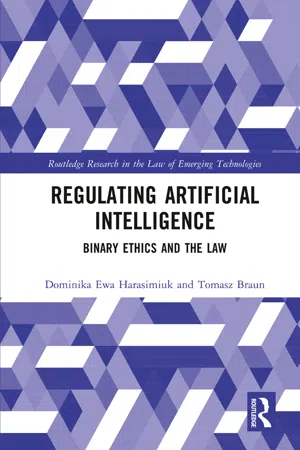
Regulating Artificial Intelligence
Binary Ethics and the Law
- 188 pages
- English
- ePUB (mobile friendly)
- Available on iOS & Android
Regulating Artificial Intelligence
Binary Ethics and the Law
About this book
Exploring potential scenarios of artificial intelligence regulation which prevent automated reality harming individual human rights or social values, this book reviews current debates surrounding AI regulation in the context of the emerging risks and accountabilities. Considering varying regulatory methodologies, it focuses mostly on EU's regulation in light of the comprehensive policy making process taking place at the supranational level.
Taking an ethics and humancentric approach towards artificial intelligence as the bedrock of future laws in this field, it analyses the relations between fundamental rights impacted by the development of artificial intelligence and ethical standards governing it. It contains a detailed and critical analysis of the EU's Ethic Guidelines for Trustworthy AI, pointing at its practical applicability by the interested parties. Attempting to identify the most transparent and efficient regulatory tools that can assure social trust towards AI technologies, the book provides an overview of horizontal and sectoral regulatory approaches, as well as legally binding measures stemming from industries' self-regulations and internal policies.
Frequently asked questions
- Essential is ideal for learners and professionals who enjoy exploring a wide range of subjects. Access the Essential Library with 800,000+ trusted titles and best-sellers across business, personal growth, and the humanities. Includes unlimited reading time and Standard Read Aloud voice.
- Complete: Perfect for advanced learners and researchers needing full, unrestricted access. Unlock 1.4M+ books across hundreds of subjects, including academic and specialized titles. The Complete Plan also includes advanced features like Premium Read Aloud and Research Assistant.
Please note we cannot support devices running on iOS 13 and Android 7 or earlier. Learn more about using the app.
Information
1 Instead of Introduction – Algorithmic Society, Artificial Intelligence and Ethics
1.1 Topic’s relevance
1.2 Goal of the book
Table of contents
- Cover
- Half Title
- Series Page
- Title Page
- Copyright Page
- Contents
- 1 Instead of introduction – algorithmic society, artificial intelligence and ethics
- 2 Re-defining of Artificial Intelligence
- 3 EU Policy making in the AI field
- 4 Values first – ethic guidelines for trustworthy AI as a bedrock of regulatory approach
- 5 Non-technical methods of achieving trustworthy AI
- 6 Horizontal regulatory approach
- 7 Sectoral regulatory approach
- 8 Conclusions
- Bibliography
- Index